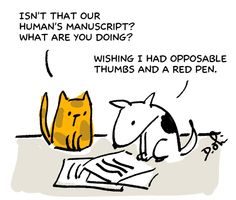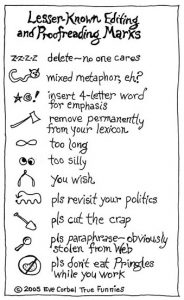How to Be a Great Editor
One of my favorite parts of writing classes was peer-edit. I was the one who enjoyed crossing out sentences and circling punctuation errors in my red pen. Which is probably why no one wanted to be partners with me on those days.

Anyways, there is a lot more to editing than making corrections. Editors review text for completeness, accuracy, visual design and overall effectiveness. They should be proficient in grammar, spelling and punctuation and have some knowledge on the topic they are editing. They should also be organized and have an eye for style.
There are three types of text editing:
- Comprehensive (Deep) Editing: Editor shares responsibility with writer for content and usability; basic copyediting plus content evaluation and comprehension
- Basic Copyediting: Editor checks for correct spelling, punctuation, and grammar; for consistency in mechanics; and for accuracy and completeness
- Proofreading: Editor ensures previously noted errors are corrected and any new procedures completed
Before starting the editing process, the writer should specify what exactly they want from the editor. Good communication ensures the editor and writer are on the same page and get tasks done on time.

When an editor makes changes, they have to keep the author’s meaning and writing style in mind. An editor’s job is ensure the meaning and purpose of the document is clear to the reader. They do not mess with the writer’s style or content unless it is unclear or inconsistent. While an editor may not like a how an author uses certain words, it may be the author’s writing style. Editors can suggest style changes, but it is up to the writer to accept them.
Editors need reasons to make corrections in a document. They cannot say, “I don’t like this word, get rid of it” or “This comma doesn’t go here.” Incorrect use of punctuation, grammar, or cohesion would be reasons editors would give for making change; making changes “just because” can change the meaning of the document.
Here are some editing tips:
-

Photo credit: vappingo.com Communication is key. You and the writer should have constant communication throughout the editing process. Every change and question should be noted in a text markup system or preferred method of communication.
- Create a style guide before editing. A style guide tells the writer and editor how certain words will be spelled or abbreviated, what fonts will be used, etc. If you both use the style guide, you will save time in the end stages of editing.
- Are you deep eating, copyediting or proofreading? Does the writer just want style tips? Always ask the writer what they want before you edit. You could be doing hours of work when all they wanted was a proofread.
- Determine how edits will be made. Will you edit an electronic copy with markup software or a hardcopy with ink and markup symbols? Some writers might not be familiar with markup software and prefer a hardcopy.






